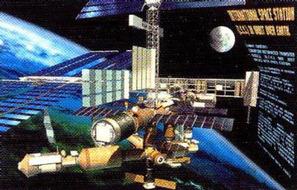| Space
/ Galaxies |
Mars
/ NASA |
Man
in Space |
Space
/ Earth |
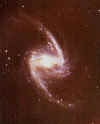 |
 |
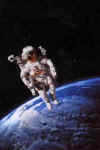 |
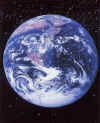 |
 |
Our
solar system is not alone,
we are surrounded by hundreds
of thousands of stars. If you
look up on a dark cloudless night
you might see what appears to
be clouds in space. What you
are seeing is in fact thousands
of other distant stars that are a
group of stars we call the Milky
Way Galaxy. The Milky Way
Galaxy is one of many galaxies.
Our universe is probably made
up of over 100 billion galaxies.
The Milky way Galaxy is what we
call a spiral galaxy. It has many
arms that spiral around its
center. It was named because
the band of bright stars
reminded our ancestors of
mothers milk. |
How
far is mars from the sun?
The semi-major axis of
Mars'
orbit about the sun is 1.52
Astronomical Units (A.U.) or 142
million miles (228 million km). How
far is Mars from the Earth? At
the 2001 Mars opposition, the
planet was approximately 43
million miles (68 million km) from
Earth. What are the dimensions
of Mars? Mars has a diameter of
4,222 miles (6,794 km) at the
equator. The Martian surface
contains thousands of impact
craters because, unlike Earth ,
Mars has a stable crust, low
erosion rate and no active
sources of lava. So, impact
craters on Mars are not
obliterated as they are on Earth. |
In
1957 Russia put into orbit
the first satellite, Sputnik, and
the first animal, Laika the dog.
In 1961 Yuri Gagarin of the
USSR is the first human in space,
followed by Alan Shepard of the
United States. President
Kennedy sets the ambitious goal
of landing on the moon before
the decade ends. In 1963
Valentina Tereshkova of the
USSR is the first woman in
space. On July 20, 1969,
humans land on the Moon
aboard Apollo 11. Neil Armstrong
and Buzz Aldrin collect lunar
samples and return them to
Earth. In 1971 the USSR sends
up Salyut 1, the first orbital
space station. |
Scientists
believe our universe
began with a "big bang" some
12-15 billion years ago. If all the
events in the history of the
universe until now were
squeezed into 24 hours, Earth
wouldn't form until late
afternoon and humans would
have existed for only two
seconds. The Earth's surface is
rotating about its axis at 1,532
feet per second at the equator,
and the planet zips around the
Sun at more than 18 miles per
second. Perhaps Earth's most
distinguishing factor, is the
presence of water, which
contributed to the formation
of life some 3,000 million years
ago. |
 |
 |
 |
 |
A
galaxy is a
huge collection of
stars, gas and dust measuring
many light years across. There
are many different types of
galaxies, spiral, elliptical and
barred spiral as well as many
others. Andromeda is a spiral
galaxy , M87 a Giant Elliptical
galaxy is surrounded by many
globular clusters, The whirlpool
galaxy is a galaxy that is
interacting with a nearby
galaxy. Antennae is two spiral
galaxies that have collided.
Centaurus A is the result of a
spiral galaxy and a elliptical
galaxy combining together.
NGC1365 is a good example of
a barred spiral galaxy. |
Mars
has a thin atmosphere and
Mars has no surface water.
Mars has a complex
surface with
features such as volcanoes,
canyons, dust storms, channels
an impact craters. Many of
these features are the largest
yet discovered in the solar
system. Some, such as
mud-flow-ejecta blankets and
chaotic terrain, have only been
found on Mars. Olympus Mons
on Mars is the largest volcanic
mountain in the Solar System.
It is 600 km across and 27 km
high! And you thought Mount
Everest (about 8 and a half km
high) was tall!
|
In 1981 the U.S. Space Shuttle
makes its inaugural flight. In
1986 the Space Shuttle
Challenger explodes less than
two minutes into its flight, killing
all seven crew members and
setting back NASA programs for
several years. Also in 1986 the
Russian Mir space station was
successfully launched into orbit.
In 1998 Russia and U.S.
cooperate in the assembly of the
first two modules of the ISS or
International Space Station.
Mars is the next
frontier for
manned space missions, but the
goal of landing a man on Mars is
at least a decade away.
|
Earth,
the third planet from the
Sun is, in scientific terms, quite
similar to the first two. In fact,
the four planets of the inner
solar system (Mercury, Venus,
Earth, and Mars) all share rock
and metal as their primary
ingredients. Each of these
so-called terrestrial planets has
a solid surface, unlike the
gaseous planets of the outer
solar system. The diameter of
the Earth is 7,926 miles.
The time it takes Earth to rotate
is 23 hours, 56 minutes.
The Earth orbits the Sun in
365.24 days. |
Space
/ Nebulas
Hubble images |
Mars
/ NASA
Bases & Spacecraft |
International
Space Station |
Space
Earth & Moon |
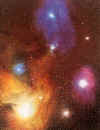 |
 |
 |
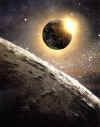 |
Above:
ISS Alpha photo
taken by Atlantis Feb 2001.
Below: Ten still animations
of future ISS look. |
The
Hubble Space Telescope
whirls around Earth at a speed
of 5 miles per second. If cars
moved that fast, a
coast-to-coast trip across the
continental U.S. would take
only10 minutes. |
A
top priority in NASA's
exploration of Mars is
understanding its present
climate, what its climate was
like in the distant past, and the
causes of climate change over
time. |
High
above the Earth lies
the International Space Station:
the first microgravity
laboratory for the whole world.
Orbital construction
began on
the International Space Station
in late 1998. |
The
moon is approximately
234,000 miles from Earth. The
moon's gravity is 1/6 that of the
earth's. So if you weigh 160
pounds on earth, you would only
weigh 26.6 pounds on the moon. |
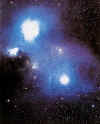 |
 |
 |
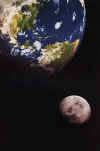 |
Engineers
designed Hubble with
servicing in mind. The telescope
is equipped with 31 foot
restraints and 225 ft. of
handrails |
 |
 |
There
are various theories about
how the Moon was created, but
recent evidence indicates it
formed when a huge collision
tore a chunk of the Earth away. |
The
tool chest astronauts use
during servicing missions
contains more than 100 tools,
including common screwdrivers
and wrenches. When a
component breaks or a more
technologically advanced
instrument becomes available,
astronauts install the new
equipment using hand and
power tools during periodic
servicing missions. By the time
Hubble's mission ends in 2005,
astronauts will have serviced it
four times-1993, 1997, 1999
and 2002-and have installed
many new instruments featuring
more advanced technology. |
A
better understanding of Mars'
current climate will help scientists
more effectively model its past
climatic behavior. To do that,
NASA will need detailed weather
maps of the planet and
information about how much
dust and water vapor are in the
atmosphere. Monitoring the
planet for this information over
one full Martian year (687 Earth
days) will help NASA understand
how Mars behaves over its
seasonal cycle and guide us
toward understanding how the
planet changes over millions of
years. |
By
2004, the Space Shuttle and
Russian rockets will conduct 45
missions, assembling the more
than 100 pieces of the 460-ton
ISS. When completed, the ISS
will house up to seven
astronauts in a conglomeration
of modules as big as two football
fields on the outside with a
habitable area the size of a 747
jumbo jet. The astronauts will
perform wide-ranging science
experiments, from studying how
to grow food in space to
observing the effects of
weightlessness on bone and
muscle loss, sleep disorders and
hypertension. |
The
Moon travels around the
Earth at a little more than half a
mile per second; its speed is
slowing and the satellite is
gradually moving away from
Earth. Our moon is moving away
from the earth at about 3cm per
year. Because it takes 27.3 days
both to rotate on its axis and to
orbit Earth, the Moon always
shows us the same face. We see
the Moon because of reflected
sunlight. How much of we see
depends on its position in
relation to Earth and the Sun. In
June of 1999, researchers
discovered by accident that a
huge cloud of sodium gas trails
behind the Moon. |
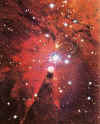 |
 |
 |
 |
 |
 |
 |
Pointing
the Hubble Space
Telescope and locking onto
distant celestial targets is like
holding a laser light steady on a
dime that is 400 miles away.
Each day, the Hubble Space
Telescope collects enough data
to fill an encyclopedia. Images
and data collected by the
telescope travel 90,000 miles
over satellite and ground links
before they reach the Space
Telescope Science Institute in
Baltimore, Maryland. |
The
layered terrain of the
Martian polar regions also holds
clues about the planet's past,
much like the rings of a tree
provide a record of its history.
When and how were these polar
layers deposited? Was the
climate of Mars ever like that of
Earth? And if so, what happened
to change the planet into the
dry, cold, barren desert it is
today? Those are the questions
that NASA missions still have to
answer. |
In
an historic space maneuver,
astronauts used the Space
Shuttle Endeavor's 50-foot
robotic Canada Arm on Dec. 7,
1998, to connect the first two
pieces of the International
Space Station. The crew of six
snagged the Russian Zarya
module from space and attached
it to the Unity connecting
module. The cost of building and
maintaining the ISS for the first
decade is expected to exceed
$100 billion. |
Like
the four inner planets, the
Moon is rocky. It's pockmarked
with craters formed by asteroid
impacts millions of years ago.
Because there is no weather,
the craters have not eroded.
The Moon has almost no
atmosphere, so a layer of dust
-- or a footprint -- can sit
undisturbed for centuries. And
without an atmosphere, heat is
not held near the planet, so
temperatures vary wildly. |
 |
 |
 |
Daytime
temperatures on the
sunny side of the Moon reach
273 degrees F; on the dark side
it gets as cold as -243. |
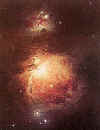 |
 |

|
Asteroids
& Comets |
 |
Placed
into a low-earth orbit in
April 1990 by the space shuttle,
the 2.4-meter Hubble Space
Telescope has since returned
some remarkable images in the
visible, near-ultraviolet, and
near-infrared wavelengths.
Some of the Hubble Nebula
images are on this page. The
Hubble Space Telescope is more
than 13 meters (43 feet) long
and 4 meters (14 feet)
wide-about the size of a bus or
tanker truck. Standing upright,
it looks like a 5-story tower. |
The
current Martian climate is
regulated by seasonal changes
of the carbon dioxide ice caps,
the movement of large amounts
of dust by the atmosphere and
the exchange of water vapor
between the surface and the
atmosphere. One of the most
dynamic weather patterns on
Mars is the generation of dust
storms that generally occur in
the southern spring and
summer. These storms can grow
to encompass the whole planet. |
The ISS by
the numbers:
-Length, end-to-end: 361 feet.
-Area covered by solar arrays:
half an acre.
-Length of batteries lined up
end-to-end: 2,900 feet.
-Windows with view of Earth: 4
-Miles of wire: 8.
-Onboard computers: 52.
-Lines of code in the software:
1.7 million. |
There
are two hypotheses about
how most of the asteroids
formed. One says they broke off
of a mother planet that existed
between Mars and Jupiter. More
likely, however, they represent
what space was like before the
planets formed, and they are
the remnants of that process --
bits and pieces that never quite
joined together. When an
asteroid, or a part of it, crashes
into Earth, it is called a
meteorite. |
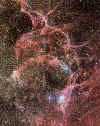 |
 |
 |
 |
 |

|
 |
A
Supernova is a massive and
bright star that has lost most of
its mass in a tremendous
explosion. A
Supernova
explosion produces more energy
in its first ten seconds than the
Sun during the whole of its 10
billion year lifetime and that for
a brief period, it creates more
energy than the rest of a galaxy
put together. Almost all of the
heavier elements in your body
(eg calcium, iron, carbon) were
made somewhere in Supernova
explosions. |
Mars
has two small moons:
Phobos and Deimos. Phobos
(fear) and Deimos (panic) were
named after the horses that
pulled the chariot of the Greek
war god Ares, the counterpart
to the Roman war god Mars.
Both Phobos and Deimos were
discovered in 1877 by American
astronomer Asaph Hall. The
moons appear to have surface
materials similar to many
asteroids in the outer asteroid
belt, which leads most scientists
to believe that Phobos and
Deimos are captured asteroids. |
The
energy in the sunlight we
see today started out in the
core of the Sun 30,000 years
ago - it spent most of this time
passing through the dense
atoms that make the sun and
just 8 minutes to reach us once
it had left the Sun. The Sun
makes up 99.86% of the Solar
System's mass. That means that
all the planets put together
(including Jupiter) as well as all
the asteroids only make up
about 0.14% of the Solar
System's mass. |
Since
the Earth was formed
asteroids and comets have
routinely slammed into the
planet. Comets are made of ice,
dust, and gases and are known
for their tails. The comet with
the longest recorded tail is the
Great Comet of 1843. Its tail
stretched over 800 million
kilometers! A massive body 100
km wide traveling at over
512,000 km/h crashed into
Mercury to form the Caloris
Basin. The impact was so great it
sent shockwaves round Mercury
creating its hilly lineated terrain. |
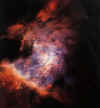 |
 |
 |
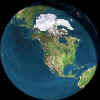
Great Blue Marble is located at
the center of this Earth image.
Center is Calgary, Canada. |
A
nebula is an interstellar cloud
of gas and dust, which is
sometimes made visible by the
reflected light from nearby
stars. Nebulae are the birthplace
of stars. |
 |
 |
The
pillar-like structures of
Nebulas are columns of cool
interstellar hydrogen gas and
dust, pre-stages of new stars
that protrude from the interior
wall of a dark molecular cloud. |
Some
rocks found on Earth are
actually pieces of Mars. Most
Mars rocks have been located in
Antarctica, where the surface
landscape rarely changes. |
Russian
Mir
Space Station
1986 - 2001 |
Earth
& Moon Viewer
Do
you want to see your
country from space?
|
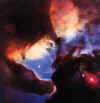 |
 |
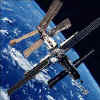
|
Click on
"
Earth & Moon
Viewer"
to see Earth from space.
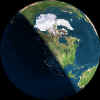
|
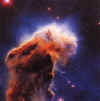 |
 |
The
Russian Mir space station
was launched in 1986, and was
successfully returned to Earth in
2001 with a controlled crash in a
remote area of the South Pacific
Ocean. |






















































